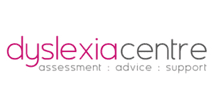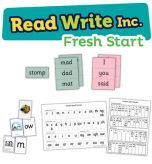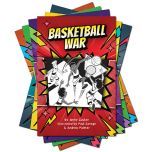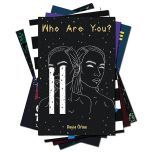Supporting readers with dyslexia in secondary schools
Dyslexia is a common learning difficulty that affects around 10% of the population in the UK, which is an estimated 970,000 school-aged children. Approximately 70–80% of these students have difficulty with reading, writing and spelling.
In secondary school, the increased demands of learning can make it challenging for dyslexic students to succeed. These challenges may not only affect their academic performance but also their confidence and self-esteem. A survey conducted by the British Dyslexia Association found that almost half (49%) of young people with dyslexia in the UK reported having low confidence in their abilities at school.
A study by the British Dyslexia Association found that dyslexic students are twice as likely to leave school without qualifications. However, a study by the University of Oxford found that dyslexic students who receive appropriate support are just as likely to succeed in school as their non-dyslexic peers.
These studies show that it is crucial to provide the right support so that dyslexic students can reach their full potential. Exploring strategies and resources available to dyslexic readers and implementing them within schools will help to improve both academic progress and students’ overall wellbeing.
In this blog, we aim to provide information about the detection and impact of dyslexia, as well as explore practical and effective ways that educators can help dyslexic students succeed in school and beyond.
Dyslexia in UK secondary schools
What is dyslexia?
Dyslexia is a learning difficulty that affects the way the brain processes language. It mainly affects the ability to read, write and spell. It can also affect people’s ability to concentrate, organise and remember things. Dyslexia can affect people of all ages and backgrounds, often runs in families and is a lifelong neurological condition that has no cure. However, there are many resources available to help people with dyslexia succeed to lead full and productive lives.
The following definition was adopted by the International Dyslexia Association in 2002 and is used by the National Institute of Child Health and Human Development:
Dyslexia is a specific learning disability that is neurobiological in origin. It is characterized by difficulties with accurate and/or fluent word recognition and by poor spelling and decoding abilities. These difficulties typically result from a deficit in the phonological component of language that is often unexpected in relation to other cognitive abilities and the provision of effective classroom instruction. Secondary consequences may include problems in reading comprehension and reduced reading experience that can impede growth of vocabulary and background knowledge.
The video below, from the British Dyslexia Association, explains dyslexia in more detail:
Is dyslexia a disability?
Yes. The Equality Act 2010 defines a disability as a physical or mental impairment that has a ‘substantial’ and ‘long-term’ negative effect on your ability to do daily activities. Dyslexia is a learning difficulty that affects reading, writing, spelling and concentration. It is a lifelong condition that cannot be cured. As such, it meets the definition of a disability under the Equality Act 2010.
This means that schools have a duty to make reasonable adjustments to ensure that dyslexic students are not discriminated against. This could include providing extra support and aids, making changes to the way that lessons are taught and providing students with extra time in internal tests and external exams. By providing the right support, schools can help students with dyslexia reach their full potential.
How many secondary school students have dyslexia?
It is estimated that around 10% of secondary school students in the UK have dyslexia. This equates to approximately 420,000 students.
Understanding the impact of dyslexia on reading
Slow learners or specific learning difficulties?
Dyslexia is not an indicator of intelligence and students with dyslexia do not have a slower rate of learning than other students. However, they may have difficulties with specific areas of learning, such as the ability to recognise letters of the alphabet. These difficulties can make it challenging for students with dyslexia to keep up with their peers in the classroom.
How does dyslexia affect reading?
A student with dyslexia may have difficulty decoding words, understanding what they read, or reading fluently.
Decoding words: They may have difficulty sounding out words, or they might mix up similar-looking words.
Understanding what they read: They may have difficulty understanding the meaning of what they read or have trouble following along with a story.
Reading fluently: They may read slowly and with difficulty, or they may skip words or lines.
Does dyslexia just affect reading?
No, dyslexia can also affect writing, spelling and sometimes speaking. Students with dyslexia may have difficulty doing the following:
- recognising and remembering letters and words
- sounding out words
- spelling words correctly
- distinguishing between similar sounding words
- putting thoughts into writing
- forming letters neatly or writing legibly
- following directions
- organising their thoughts
- paying attention
- managing time.
Effective strategies for supporting students with dyslexia
What professional help is there for young people with dyslexia?
There are several options for professional help available to secondary school students with dyslexia. These include:
- Educational psychologists.
These are qualified professionals who can assess students for dyslexia and provide recommendations for support. They can also work with teachers and parents to develop individual education plans (IEPs) for students with dyslexia. - Special educational needs (SEN) teachers.
These teachers can help to provide additional support to students, such as accommodations or modifications to help students with dyslexia succeed in the classroom. A SENCO (special education needs coordinator) plays a very important role in leading the coordination of provision for children and young people with special educational needs and disabilities (SEND) in schools.
Tutors.
Tutors can provide one-to-one or small group instruction to students with dyslexia. As well as helping them with their reading, writing and spelling, they can also provide strategies for learning and studying.
Dyslexia charities.
There are many dyslexia charities that can provide information, support, and resources to students with dyslexia and their families. These charities can offer information about dyslexia, support groups, and funding for tutoring and other services. Some of the main dyslexia charities in the UK include:
Dyslexia Action is a charity that provides online accredited dyslexia training.
The Dyslexia-SpLD Trust is available for anyone seeking to assess and improve their knowledge and skills in respect of literacy and supporting the Dyslexic learner.
The Dyslexia Centre provides educational assessment, advice and support to adults, parents, children and educational staff regarding dyslexia and other specific learning difficulties.
Is there funding to support students with dyslexia?
Yes. Funding to support students with dyslexia can be used to provide a range of services including assessment, tutoring, assistive technology, extra time on tests and accommodations in the classroom.
Funding is available from a variety of sources, including the government, local authorities, and charities.
Schools looking to access funding for students with dyslexia can do so through:
The Pupil Premium: This is a government funding allocation that is given to schools to support students who are eligible for free school meals or who have special educational needs.
Local authority funding: This can also be used to support students who have dyslexia. Schools need to contact their local authority to apply for this funding.
Charity funding: There are several charities that provide funding to support students with dyslexia. To find out more about charity funding, schools can contact the charities directly or through their local authority.
What can educators do at school to support dyslexic readers to succeed?
Early identification and intervention can make a big difference in helping people with dyslexia learn to read effectively. Extra classroom support can help students with dyslexia keep up with their peers. This support might include small group instruction, one-to-one tutoring, or the use of assistive technology. There are also many educational resources available to help students with dyslexia learn and read effectively. These resources can include books, software, and online programmes. Teaching students to identify their strengths and weaknesses, communicate their ideas to others and know when and how to ask for help when they need it will also teach dyslexic learners how to advocate for themselves.
What does a dyslexia-friendly classroom look like?
The classroom would need to be organised and structured in a way that minimises the challenges that students with dyslexia face, making it easier for them to learn. This could include:
- Reduced visual clutter. Clutter can be distracting for students with dyslexia, so the classroom should be kept as uncluttered as possible. This means removing unnecessary objects from the walls and desks and keeping the room well-organised. Maintaining visual clarity of the room will enable a more focused learning experience.
- Appropriate use of colours and contrast. Muted colours on the walls and displays will help to reduce sensory overload. Consideration should also be given to the use of the blackboard or whiteboard, to ensure it is not overstimulating in contrast.
- Good lighting. Good lighting is important for all students but is especially important for students with dyslexia. Dyslexic students may have difficulty seeing print, so it is important to make sure that the classroom is well-lit but without glare. Arrange tables and chairs to give the best access to natural light and ensure artificial light is bright and evenly distributed.
- Dyslexia-friendly fonts and text types. Dyslexic students may have difficulty reading small print or certain fonts. It is important to use dyslexia-friendly fonts and text sizes, which are designed to be easier for dyslexic students to read. Fonts such as Dyslexie, OpenDyslexic and Comic Sans aid readability whilst reducing reading fatigue and visual spacing issues.
- Adequate time for tasks. Dyslexic students may need more time to complete tasks than other students. This is because they may have difficulty processing information and completing tasks in the same way as other students. It is important to allow them adequate time and not to rush them.
- A multi-sensory approach. Dyslexic students may learn best in different ways. Some students may learn best by listening, while others may learn best by seeing or doing. A multi-sensory approach including visual aids, tactile activities and verbal instructions will help children with dyslexia benefit from the use of sight, sound, and touch. Providing a variety of learning materials in the classroom will mean all students can learn in the way that works best for them.
- Technology-friendly. Consider the use of technology in the classroom, such as word processing software, eBooks, podcasts, audiobooks, or digital reading apps, for a better learning experience.
- Assistive technology. Providing assistive technology, such as text-to-speech software, speech-to-text, and other software-based support systems, will help students with dyslexia to communicate their understanding easily.
A supportive and collaborative environment. A dyslexia-friendly classroom is one where students feel supported and encouraged. This means that the teacher and other students should be understanding of the challenges that dyslexic students face. It is also important to create a positive and encouraging environment in the classroom, where all students feel comfortable and safe.
How can parents support their dyslexic child at home?
Parents play an important role in supporting their dyslexic child’s academic growth and wellbeing. It is essential to understand dyslexia, communicate effectively with the school, and establish an enabling home environment by encouraging self-esteem and the facilitation of assistive technology. Here are some top tips to share with parents:
- Create a dyslexia-friendly environment at home. This means providing a quiet, well-lit place to study and using dyslexia-friendly materials such as large print books and text-to-speech software.
- Be patient and understanding. Dyslexia can be frustrating for young people, so it’s important to be patient and understanding. Help your child to develop strategies for coping with their dyslexia and praise their efforts, even if they don’t always succeed.
- Encourage your child to read. Reading is one of the most important things that students can do to improve their literacy skills. Encourage your child to read for pleasure and help them to find books that they enjoy.
- Help your child with their homework. If your child is struggling with their homework, offer to help them. However, it is important to let them do as much of the work as they can on their own.
- Get involved in your child’s education. Attend parent-teacher conferences and get to know your child’s teachers. This will help you to understand the challenges that your child is facing and to work with the school to find ways to support them.
- Consider extra support. You might consider seeking additional support for your child’s learning, such as after-school homework clubs, one-to-one lessons with a private tutor, or extra support from your child’s teacher.
Join a dyslexia support group. There are many dyslexia support groups available for parents and students. These groups can supply information, support and advice.
Resources for supporting students with dyslexia
Are there reading books designed specifically for supporting dyslexic students?
Absolutely. As well as a range of other potential reading difficulties. Books to engage reluctant and struggling readers have been at the heart of Badger’s publishing brand for over twenty years. There are over 30 hi-lo series available for supporting engagement and progress in reading, for those who may be finding it difficult or who are falling behind. Our books include an ever-increasing range of features to ensure they are super-readable for as many children as possible, including for dyslexic readers. All titles are individually levelled by their reading age and interest age and have been assessed by Accelerated Reader™. Downloadable PDF versions are also available online as an alternative for children who may prefer a digital ‘way in’ to reading. Popular collections include:
View all series HERE
Barrington Stoke also offer a wide range of books that are super-readable and use a variety of features to make them more accessible for students with dyslexia.
What are the features of a reading book that is more accessible for dyslexic and struggling readers?
Badger Learning uses several features such as breaking up text into chunks, easily readable fonts, wider line spacing and supportive illustrations to help pupils to read our books. We have a wide range of titles with diverse authors, characters, and themes to suit pupils with different interest ages and reading ages, including very low reading age books for older teenagers, which can be hard to source.
Our various hi-lo series include either some or all of these key features:
- Dyslexia-friendly font and line spacing.
- Bite-sized chunks of text.
- Engaging illustrations that support pupils’ understanding of the text.
- Age-appropriate stories and subjects, with the look and feel of a ‘real’ book.
- Realistic amounts of text.
- A variety of themes and genres to engage every reader.
- Gripping, accessible stories.
- Fascinating non-fiction subjects to engage young minds.
- A vocabulary page and questions at the end of the book to aid comprehension.
- A glossary of less familiar words.
- Downloadable PDF versions available online at badgerlearning.co.uk/ebooks-for-primary-schools.html.
Are there structured phonics books and resources suitable for secondary school pupils who have significant reading delay?
Yes, and supporting secondary school students in increasing their phonic knowledge and closing the reading gap is very important. Phonics is an essential skill for learning to read and being able to read fluently is the key that unlocks all other areas of learning.
Read Write Inc. Fresh Start is a catch-up and intervention programme, with proven results for 9–13-year-olds still learning to read. Developed by Ruth Miskin, Read Write Inc. Fresh Start uses a proven phonics-based approach and:
- Engages students with high-interest, age-appropriate reading materials.
- Accelerates students’ progress with finely levelled Modules, supplemented by age-appropriate Anthologies.
- Includes a clear structure to help you fit Fresh Start into your timetable, with step-by-step teacher guidance and detailed lesson plans that integrate all reading activities.
Fresh Start can be delivered flexibly, depending on the number of students who need it in your school, and the number of staff you have available to teach it. It consists of modules, anthologies, and online resources that aim to boost reading fluency and comprehension.
View Read Write Inc. Fresh Start HERE
Is it important to have age-appropriate books for dyslexic students?
Absolutely. A student with dyslexia already faces challenges that can make it difficult for them to read, but when given a book that is too difficult for them, it can be even more frustrating and discouraging. Equally, a book that is too easy will not be engaging enough and they may quickly lose interest.
Not only is it important to make sure the books are accurately matched to a student’s reading level, but the interest level also has to be right. Sometimes, dyslexic students are offered books designed for younger children, which can affect their confidence and put them off reading completely.
Accurately matching books to a student’s age and interest level can help them to find books they are able to read and is more likely to give them an enjoyable reading experience. Developing a love of reading is much more likely to lead to success in school and in life.
Can eBooks help dyslexic readers?
Yes, eBooks can help dyslexic readers by allowing them to customise their reading experience in the following ways:
- Text to speech: This function can read the text aloud for the reader, which can help with comprehension and pronunciation.
- Background colour: Changing the background colour can reduce glare and eye strain, and some dyslexic readers may find certain colours easier to read than others.
- Font type: Some fonts are designed to be more dyslexia friendly. These fonts use different shapes and weights for each letter to reduce confusion and flipping.
- Magnification: Enlarging the text size can make it more readable and less crowded for dyslexic readers.
- Line spacing: Increasing the space between lines can also improve readability and reduce visual stress.
Where can I find eBooks for struggling or reluctant readers?
Badger Learning stocks a wide range of eBook PDFs suitable for secondary students. They are perfect for providing an alternative way of accessing books for reluctant and struggling readers who feel traditional print books are not for them. Digital books can be an effective ‘way in’ to reading, using a format that is more associated with technology and gaming, potentially increasing willingness to try again. Hi-lo books can also be ideal for students who need age-appropriate, engaging books with accessible text.
View Badger Learning’s full range of eBooks HERE
Are there books with diverse and neurodiverse characters that are suitable for dyslexic students?
Badger Learning diversity packs are collections of books that aim to promote diversity and inclusion in schools. They cover themes such as identity, culture, race, ethnicity, gender, sexuality, disability, mental health, family, community, and social justice. View our Diversity & Inclusion books HERE
Can audiobooks help dyslexic readers?
Yes, audiobooks can be a great way for dyslexic readers to enjoy books. Listening to audiobooks can help dyslexic readers to:
- Improve their reading comprehension.
- Build their vocabulary.
- Increase their fluency.
- Reduce their stress levels.
- Improve their self-confidence.
Audiobooks can also be a great way for dyslexic readers to access books that they might not be able to read on their own. For example, dyslexic readers who have difficulty reading small print or who have trouble staying focused reading page after page can still enjoy books by listening to them being read.
5 tips for dyslexic readers who are using audiobooks:
- Choose audiobooks that are read by a narrator who you enjoy listening to.
- Listen to audiobooks at a comfortable pace.
- Take breaks when you need them.
- Don’t be afraid to rewind or replay sections that you don’t understand.
- Use audiobooks to supplement your reading, not replace it.
Assistive technology for dyslexic students
What is assistive technology?
Assistive technology (AT) refers to any device, software or product that helps people with disabilities to live more independently and participate fully in society. AT can be used to help with a wide range of disabilities, including dyslexia.
What are the most common examples of assistive technology for dyslexic students?
There are many assistive technologies that can be used to support dyslexic students in secondary school. Some of the most common examples include:
- Text-to-speech software. This software reads aloud text that is displayed on a computer or other device. This can be a great help for dyslexic students who struggle with reading comprehension or the ability to visually review and spot errors in their writing.
- Dyslexia-friendly fonts. These fonts are designed to be easier for people with dyslexia to read. Features of these fonts include increased spacing between letters, simple fonts without extra strokes or details, a larger font size, and letters that are weighted at the bottom to reduce the chance of flipping, as well as ensuring that each letter has a unique shape.
- Spell checkers. Spell checkers can help dyslexic students to identify and correct spelling errors. This can be a major time saver, and it can also help to improve the accuracy of a student’s work.
- Grammar checkers. Grammar checkers can help dyslexic students to identify and correct grammar errors. This can be another major time saver, and it can also help to improve the clarity of a student’s writing.
- Speech-to-text software: Dictation software allows students to speak their thoughts into a computer or other device, which is then converted into text. This can be a great help for dyslexic students who struggle with writing.
- Magnification software. Magnification software can enlarge text and images on a computer or other device. This can be a great help for dyslexic students who have difficulty seeing small print.
- Colour filters. Colour filters can change the colour of text and images on a computer or other device. This can be a great help for dyslexic students who are sensitive to certain colours.
- Learning software. There are a number of learning software programs that can be used to help dyslexic students with a variety of skills, such as reading comprehension, spelling, and grammar. These aids help students with dyslexia to learn in a way that is most effective for them. For example, by helping them to remember information, organise their thoughts or stay focused.
How do I know which assistive technology to use for my student?
It is important to note that not all assistive technologies will be effective for every dyslexic student. It is important to work with a qualified professional to determine which assistive technologies are most likely to be helpful for a particular individual.
Moving towards inclusive education for all students
What is neurodiversity?
Neurodiversity is a term used to describe the variety of ways that human brains function. Neurological conditions include people with autism spectrum disorder, attention deficit disorder and dyslexia.
The neurodiversity movement emerged in the 1990s as a way to challenge the view that neurological differences are deficits. Neurodiversity advocates argue that these differences are simply different ways of being human and that they should be respected and celebrated. There is also a growing body of evidence that suggests that neurodiversity can be a source of strength. The neurodiversity movement is working to create a more inclusive society that celebrates the diversity of human brains. This includes advocating for accommodations for students with neurological differences in schools and raising awareness of the strengths and contributions of neurodivergent people.
What are the strengths of a dyslexic person?
People with dyslexia have a variety of strengths that can help them succeed in life. These might include:
- Creativity. They are often very creative and have a unique way of looking at the world. This can help them come up with new and innovative ideas.
- Problem-solving skills. They are often able to think outside the box and come up with creative solutions to problems.
- Visual learners. They are often visual thinkers and learners and have a strong ability to see patterns.
- Intuition. They may be able to sense things others cannot, which can give them an advantage in many different situations.
- Determination. They often have a strong determination to succeed. They may face challenges that others do not but are not easily discouraged.
What is Dyslexia Awareness Week?
Dyslexia Awareness Week is an annual event held in the UK to raise awareness of dyslexia. It is organised by the British Dyslexia Association (BDA) and takes place in the first week of October.
Dyslexia Awareness Week aims to educate others about dyslexia, its symptoms, and the available support. It is also a great opportunity to raise awareness of the challenges that people with dyslexia face and to celebrate the achievements of people with dyslexia.
If you think you know someone with dyslexia, it is important to get a diagnosis. This can help you to access the right support for them. You can find more information about dyslexia and getting a diagnosis on the BDA website.
Helpful Links:
Badger Learning Blog: Books to Boost Reading Confidence and Help Students Catch Up
Literacy and numeracy catch-up strategies (DfE 2018) — Literacy and numeracy catch-up strategies

















